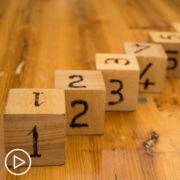What Myeloma Patient Monitoring Occurs After Induction Therapy?
What Myeloma Patient Monitoring Occurs After Induction Therapy? from Patient Empowerment Network on Vimeo.
What is involved in myeloma patient monitoring following induction therapy? Expert Dr. Ola Landgren from University of Miami Sylvester Comprehensive Cancer Center discusses some common treatment and monitoring scenarios that he carries out with his patients.
Download Guide | Descargar Guía
See More from START HERE Myeloma
Related Programs:

|

|

|
Transcript:
Lisa Hatfield:
So I think we’re going to shift a little bit to managing and monitoring multiple myeloma. Once you’ve had a patient go through the induction therapy, what kind of monitoring do you complete for your myeloma patients and in particular those who have reached a certain level response and are maybe on maintenance or continuous therapy, what type of tests do you do and how often regarding labs, imaging, bone marrow biopsies?
Dr. Ola Landgren:
There are a lot of different ways, obviously, of practicing medicine. So every center has developed models that they feel very comfortable doing. So I like details. I like to know things. I like to check things. I’m not excessive in ordering invasive tests, but I like to know. Also, I like to make sure the patient not only has good long-term clinical outcomes, but also good quality of life. And to me, I try to minimize the intrusiveness of what we do. So, for example, if I give a combination therapy where there is an injection or infusion, say week one, week two, week three, and then there is a week off. I recognize that if you do labs during that week off, you will have a better yield and understanding of how these three different injections or infusions actually have moved the disease forward and suppressed the disease.
But in my mind, I think that week off is a very important week off for the patient. So I would rather do testing the third day of the treatment at the treatment unit. So if it’s week one, week two, week three, I would draw the myeloma labs that same day. And that would give the patient six more days off from injection, infusion that third week and the whole fourth week off. So I would give the patient 13 days off. Again, these are small things. These are things I’ve thought about a lot. I’ve practiced medicine for many years and I recognize that having time off like that, many patients travel, they go on vacation, they do different things. So I don’t want to just randomly put a blood test in the fourth week just because I want to check after week one, two, three, and then have the assessment.
I sort of underestimate the benefit of the therapy and then I start the next cycle, say back to back cycle two and cycle three and so forth. I would typically do blood tests once a month following these principles. I do baseline and I would do the last day of injection or infusion. For a newly diagnosed patient, you ask me, I would for baseline always do bone marrow biopsy and an aspirate. I would always do a PET-CT for every patient as my default.
Sometimes we end up doing MRI. So that could be other things that are happening, but that is what we do for the majority of our patients. After we have completed four to six cycles of treatment for patients that are candidates for consideration of transplant with chemotherapy with melphalan (Alkeran), we would usually do a biopsy after four to six cycles and we would use that to determine what’s the optimal mobilization protocol for stem cells. When we do that, we would run a MRD test.
We would run our in-house flow cytometry test that we developed when I used to work at Sloan Kettering and we have developed that here in Miami as well. We work closely with Sloan Kettering, and we have set up this assay in collaboration in the new 2.0 version. We will also send the aspirate for the clonoSEQ at Adaptive Biotech, which is the DNA-based sequencing for MRD. We would send the patient for collection of stem cells. When the patient is back, we will continue treating. So if you say we do it after four cycles, we would collect, if we do it after five or six, then we collect.
After that, we would typically resume therapy and for the majority of our patients, we actually give around eight cycles of therapy, and we have seen that you can deepen the response. You don’t increase the toxicity, but you deepen the response for the vast, vast majority of our patients. When we have used our best therapies, we have done it that way…
We have even published on this, over 70 percent of our patients are MRD-negative, and many of those patients, when they come to cycle eight, they ask, do I have to do the transplant? And that is a controversial topic. But I think there are two large randomized trials that have shown the same thing, that there is no survival benefit with transplant. But you can also say that there is, in those two trials, a progression free survival benefit, meaning that the disease would stay way longer with transplant. But many patients say, if I reach MRD-negative, both those two trials show that if you’re MRD-negative without transplant, or you’re MRD-negative with the transplant, PFS was actually the same.
And given that there is no survival, overall survival benefit, why would I subject myself to go to that? Why don’t I keep the cells in the freezer and go right to maintenance? And we will have a conversation with every patient, they would meet our transplant team, they would meet our myeloma expert team.
And the individual patient will make decisions. I think over time, more and more patients have chosen to keep the cells in the freezer. For patients that are MRD-positive, we would counsel towards transplant, but there are patients that don’t want to do that, and we are not forcing any patients to do that. We would give patient maintenance, and on some of our trials, we use the standard of care, which is lenalidomide (Revlimid) maintenance. And we are also developing new approaches where we have done daratumumab (Darzalex) added once a month with lenalidomide. We have gone one year, and we have started to do two years of that. And after that, we would stop daratumumab and just do lenalidomide maintenance.
Lastly, to answer your question fully here, we would do a PET-CT in the bone marrow after the eight cycles as a repeat, and we would offer a patient to check on maintenance on an annual basis, and this is in accord with the NCCN guidelines. So a lot of details here, but you asked me how we do testing.






